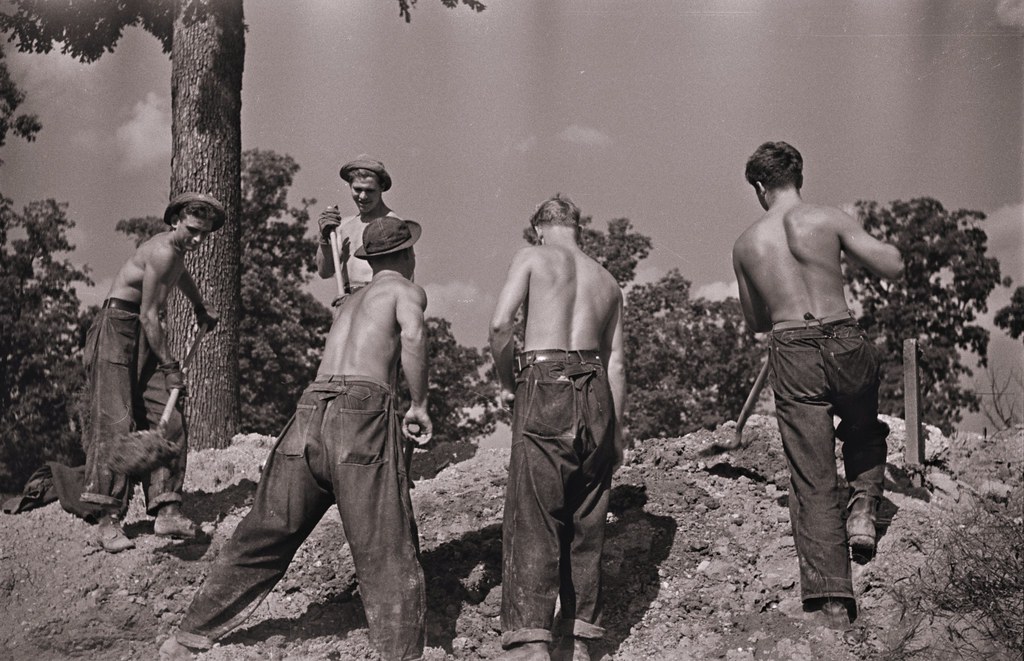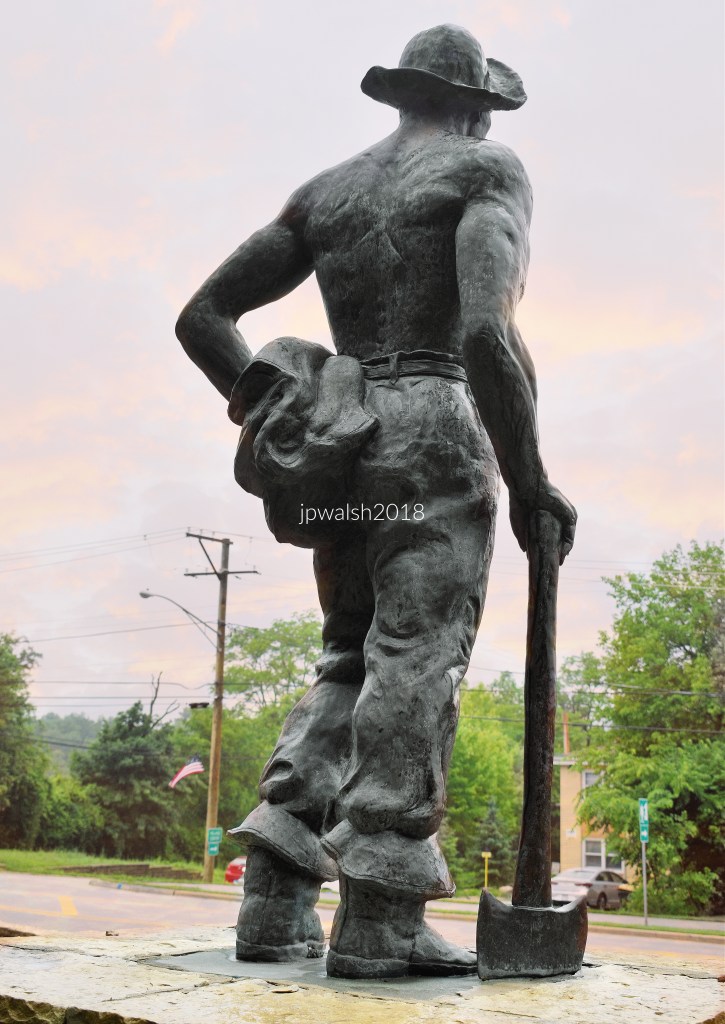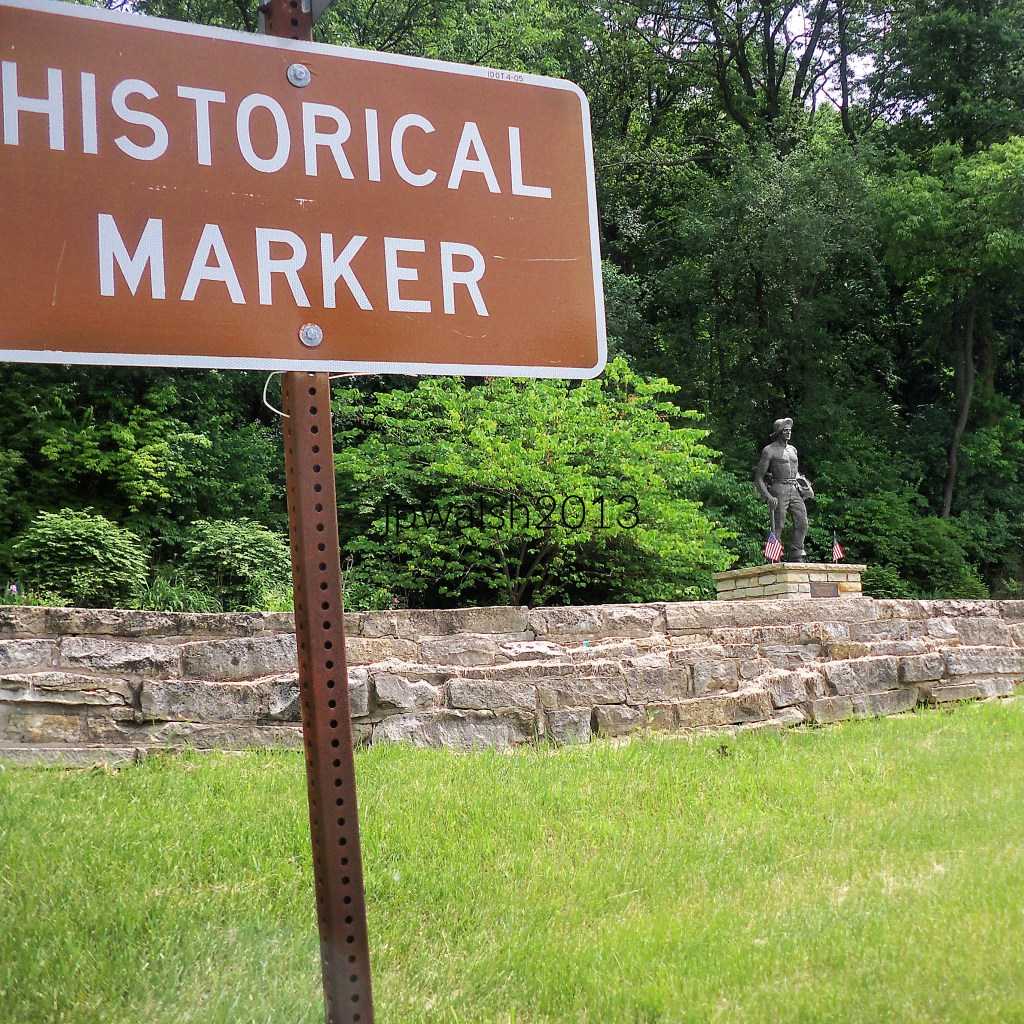
FEATURE Image: Cook/DuPage Cos., Willow Springs, IL. The Worker, Civilian Conservation Corps (CCC), Camp Chicago-Lemont, Company 612, est. June 4, 1933. Author’s photograph, 6/2018 6mb.
The Civilian Conservation Corps (CCC) was a major program in President Franklin Roosevelt’s New Deal. Called “Mr. Roosevelt’s Tree Army,” there were over 50 such camps in Illinois alone and over 1000 special projects in the state between April 1933 and July 1942. The camp at Willow Springs was one of FDR’s first such camps established in spring 1933. The Civilian Conservation Corps Legacy indicates June 4, 1933 as the establishment date for Camp Chicago-Lemont, Company 612 in Willow Springs, Illinois.
The recent statue called The Worker was dedicated on June 3, 2001 to commemorate the dedication and spirit of the young men, aged 17 to 28 years old, who served in the CCC and specifically in Willow Springs, Illinois. The larger-than-life-sized bronze CCC Worker Statue stands at the intersection of Archer Avenue (Route 171) and Willow Boulevard in Willow Springs Woods, and is one of many such similar statues that stand on the American landscape in tribute to the men of the CCC.
The purpose of this government “alphabet” program, one of the New Deal’s most successful, was multi-faceted. The primary motivation was to address staggering unemployment numbers of up to 25% (and higher in certain pockets of the country) caused by the collapse of the private enterprise system in the Great Depression that started on Wall Street in October 1929. The CCC was specifically designed to give jobs to young men and so to relieve their families who had great difficulty finding jobs during the Great Depression.




Camps proliferated all over the country in every state. In its nine years and 3 months duration the CCC employed upwards of 3 million young men between 17 and 28 years old. For their manual labor jobs related to conservation and the development of natural resources provided by the federal program, these men received their food, clothing, lodging, medical and dental attention, along with a paycheck of $30 a month (around $600 in today’s dollars), most of which ($25) had to be sent home to their struggling families. The popular program enjoyed wide bi-partisan and public support.
Each camp could house around 200 men and, while the lifestyle was quite simple, it beat panhandling on the streets in the mind of most of the CCC’s young enrollees.

The Emergency Conservation Work (EWC) Act, or CCC, was part of the Emergency Session of the 73rd Congress that FDR called on March 9, 1933, just days after his first inauguration. FDR promised if granted emergency powers he would have 250,000 men in camps by the end of July 1933. Senate Bill S. 598 was introduced on March 27, 1933, passed both houses of Congress and was signed by FDR on March 31, 1933, less than one month into his 4-year term. Though opposed at first by Big Labor who feared that jobs would be filled by this army of non-union workers, the Roosevelt Administration went ahead and mobilized the men, material, transportation and necessary bureaucracy to establish the CCC on a scale never seen before in the United States in peacetime. Dated April l5, 1933, Executive Order 6101 authorized the program, appointed Robert Fechner (1876-1939) as its first director and established an Advisory Council with representatives from the War, Labor, Agriculture and Interior Departments. It was part of “the 100 days” that marked the passage into law of a series of 15 major bills during FDR’s first 100 days as the 32nd U.S. president.
The Federal program provided that these work projects took place mostly on rural lands owned by government entities. CCC workers throughout the country were credited with renewing the nation’s decimated forests by planting an estimated three billion trees between 1933 and 1942. Their work also revived the nation’s crumbling or nonexistent infrastructure.

The CCC was immensely popular, but Pearl Harbor effectively ended it. With the establishment of the draft and industry involved in the war effort, the government no longer needed to subsidize work. In 1942, the last CCC camps were dismantled or repurposed for the army.
With the exception of Social Security and the Rural Electrification Act, no program of the New Deal era has ever had a greater influence on the country. In Illinois alone, the impact was remarkable. Over 92,000 men worked in the CCC in the state. An estimated 60 million trees were planted, 400 bridges built, 1,200 miles of trail made and nearly 5,000 flood-control apparati put in place.
SOURCES:
https://ccclegacy.org/CCC_Camps_Illinois.html – retrieved May 16, 2023.
https://will.illinois.edu/21stshow/story/ccc-in-illinois-past-and-future – retrieved May 16, 2023
https://icl.coop/story-ccc-legacy-illinois/ – retrieved May 16, 2023.






